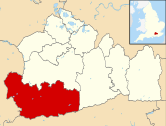
The Devil's Punch Bowl is a 282.2-hectare (697-acre) visitor attraction and biological Site of Special Scientific Interest situated just to the east of the village of Hindhead in the English county of Surrey. It is part of the Wealden Heaths Phase II Special Protection Area.

The Borough of Waverley is a local government district with borough status in Surrey, England. The borough's headquarters are in the town of Godalming; other notable settlements are the towns of Farnham and Haslemere and the large village of Cranleigh. At the 2011 Census, the population of the borough was 121,572.

The town of Haslemere and the villages of Shottermill and Grayswood are in south west Surrey, England, around 39 mi (62 km) south west of London. Together with the settlements of Hindhead and Beacon Hill, they comprise the civil parish of Haslemere in the Borough of Waverley. The tripoint between the counties of Surrey, Hampshire and West Sussex is at the west end of Shottermill.

Pendle Hill is in the east of Lancashire, England, near the towns of Burnley, Nelson, Colne, Brierfield, Clitheroe and Padiham. Its summit is 557 metres (1,827 ft) above mean sea level. It gives its name to the Borough of Pendle. It is an isolated hill in the Pennines, separated from the South Pennines to the east, the Bowland Fells to the northwest, and the West Pennine Moors to the south. It is included in a detached part of the Forest of Bowland Area of Outstanding Natural Beauty.

Elstead is a civil parish in Surrey, England with shops, houses and cottages spanning the north and south sides of the River Wey; development is concentrated on two roads that meet at a central green. It includes Pot Common its southern neighbourhood. Hamlets in the parish, marginally separated from the village centre, are Charleshill and Elstead Common, both rich in woodland. Elstead lies between Farnham and Godalming on the B3001 road about 2.2 miles (3.6 km) west of the A3 Milford interchange.
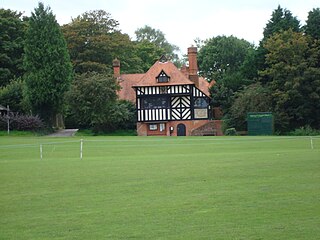
Tilford is a village and civil parish centred at the point where the two branches of the River Wey merge in Surrey, England, 3 miles (4.8 km) south-east of Farnham. It has half of Charleshill, Elstead in its east, a steep northern outcrop of the Greensand Ridge at Crooksbury Hill on Crooksbury Common in the north and Farnham Common (woodland) Nature Reserve in the west, which has the Rural Life Living Museum. As the Greensand Ridge in its western section is in two parts, the Greensand Way has a connecting spur here to its main route running east–west to the south.
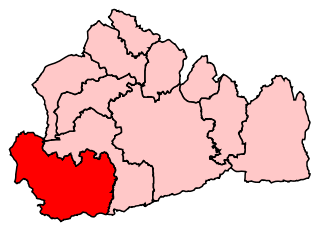
South West Surrey is a constituency represented in the House of Commons of the UK Parliament. Since 2005, the seat has been represented by Conservative MP Jeremy Hunt, the former Culture Secretary, Health Secretary and Foreign Secretary.

Godalming was an ancient hundred in the south west of the county of Surrey, England. It corresponds to the central third of the current borough of Waverley and some parts of the current borough of Guildford. Broadly speaking it extended from Guildown in the north to the border with Sussex in the south. Local people maintain the notion of the hundred, sometimes colloquially referred to as Godhelmia, mainly because of the predominance of north/south routes of communication through the area that have existed since ancient times. As recently as 1995 there were proposals to recreate a local government unit based on the old hundred borders.
Farnham was a constituency covering the south-westernmost and various western parts of Surrey for the House of Commons of the UK Parliament, 1918—1983. Its main successor was South West Surrey. The seat was formed with north-eastern territory including Woking from Chertsey in 1918 and shed the Woking area to form its own seat in 1950. It elected one Member of Parliament (MP). During its 65-year span its voters elected three Conservatives successively.
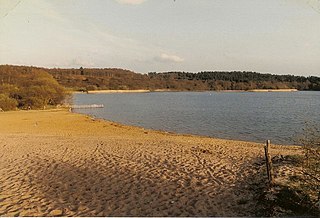
Frensham is a village in Surrey, England, next to the A287 road, 13 miles (20.9 km) WSW of Guildford, the county town. Frensham lies on the right bank of the River Wey, only navigable to canoes, shortly before its convergence with the north branch. Farnham is the nearest town, 3.5 miles (5.6 km) to the north.

Hugh Fortescue Locke King, was a British entrepreneur who founded and financed the creation of the Brooklands motor racing circuit.
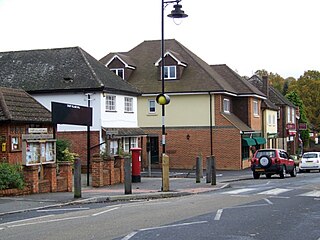
Churt is a village and civil parish in the borough of Waverley in Surrey, England, about 5.5 miles (8.9 km) south of the town of Farnham on the A287 road towards Hindhead. A clustered settlement is set in areas acting as its green buffers, which include the Devil's Jumps. The west of the village slopes down to the steep edge of Whitmore Vale, which is mostly in Headley, Hampshire; at the foot of this bank is a steeply cut brook which defines the Hampshire border. There are forests and heathland by and atop the Greensand Ridge, and the hamlet of Crosswater is in the north of the parish.

Dockenfield is a linear settlement and rural civil parish in the borough of Waverley in Surrey, England. The parish is undulating, has a number of sources of the River Wey and borders the Alice Holt Forest.

Mother Ludlam's Cave, also known as Mother Ludlum's Cave or Mother Ludlum's Hole, is a small cave in the sandstone cliff of the Wey Valley at Moor Park, near Farnham, Surrey, in England. The cave is the subject of a number of local legends. A spring rising in the cave is recorded in the 13th century "Annals of Waverley Abbey" as "Ludewell"; other spellings through history include "Ludwell" and "Luddwelle". A monk named Symon is credited with identifying the spring as a suitable water supply for Waverley Abbey in 1218, after the original source had dried up. The brothers of the abbey dedicated the spring to St Mary, so it also became known as St Mary's Well. The cave has been naturally formed by the spring but may have been enlarged by the monks and was made into a grotto and further enhanced by addition of an ironstone arched entrance, possibly during the reign of Queen Victoria.
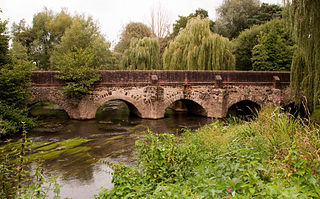
The River Wey is a tributary of the River Thames in south east England. Its two branches, one of which rises near Alton in Hampshire and the other in West Sussex to the south of Haslemere, join at Tilford in Surrey. Once combined the flow is eastwards then northwards via Godalming and Guildford to meet the Thames at Weybridge. Downstream the river forms the backdrop to Newark Priory and Brooklands. The Wey and Godalming Navigations were built in the 17th and 18th centuries, to create a navigable route from Godalming to the Thames.

The Devil's Jumps are a group of five large bell barrows situated on the South Downs 1.2 kilometres (0.75 mi) south-east of Treyford in the county of West Sussex in southern England. The Devil's Jumps site is listed as a Scheduled Ancient Monument and as a Local Nature Reserve. Most barrows along the South Downs have been damaged by agriculture and treasure hunters but the Devil's Jumps are considered to be the best preserved Bronze Age barrow group in Sussex. The barrows are laid out in a line running approximately south-east to north-west. The five barrows vary in diameter from 26 to 34 metres and stand up to 4.8 metres (16 ft) high. Two smaller barrows were situated close to the five main mounds. Traces remain of a sixth barrow. The Devil's Jumps have been dated to the Bronze Age and they are believed to be between three and four thousand years old. The Devil's Jumps were explored in the 19th century, when bones were found in two of the mounds, although some of the barrows contained no cremated remains at all. The main line of five barrows is aligned with sunset on Midsummer Day.

St Andrew's Church is an Anglican parish church in the centre of Farnham, Surrey. It is a Grade I listed building and surviving parts of the structure date back to the Middle Ages. It in the archdeaconry of Surrey, in the Diocese of Guildford. The churchyard contains the grave of William Cobbett and there is a memorial to Augustus Toplady.

The Thames Basin Heaths are a natural region in southern England in Berkshire, Hampshire and Surrey, a slightly mottled east-west belt of ecologically recognised and protected land.

Kettleness, is a hamlet in the Scarborough District of North Yorkshire, England. The settlement only consists of half-a-dozen houses, but up until the early 19th century, it was a much larger village. However, most of that village, which was on the headland, slipped into the sea as a result of instability caused by quarrying for the alum industry. Kettleness became a smaller settlement, with houses rebuilt slightly further inland.





















